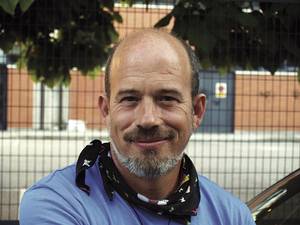In search of the first speaker
In July, an article was published in which two researchers from the Max Planck Institute, Dan Dediu and Stephen Levinson, have revived the debate on language creation. It has a significant title: In the language: the reinterpretation of Neandertal linguistic capacities and its consequences. This is what the two researchers have done in the article, who have compiled, analyzed and interpreted data and research on the ability to speak of Neanderthals and have drawn conclusions.
Its main consequence is that what we consider modern language (recognizable modern language), according to his words, was not born with modern man, but long before. They propose that Homo is a characteristic of the genre and that, at least, he had the capacity to speak the common ancestor of the Neanderthals and of the man of today. Thus, according to them, the modern language was born about 500,000 years ago and is not between 50,000 and 100,000 years old, as most have recognized to date.
To reach this conclusion, the article presents linguistic, genetic, paleontological and archaeological reasons, including a work by the researcher of Atapuerca, Ignacio Martínez Mendizabal.
Speaker, listener
Martínez's research, published in the prestigious PNAS magazine in 2004, was innovative in opening a new way of language research. Martínez himself has told how: "Words do not become fossils, nor the tissues with which they are pronounced. Therefore, to know if the hominids who lived in Atapuerca 500,000 years ago spoke, we had to find another way."
As Martínez recalled, other researchers previously tried to draw conclusions by analyzing the interior appearance of the skulls and even investigating the larynx. "But they didn't get valid results. Then it occurred to us to investigate the bones of the inner ear, which are adapted to hear our voice, our words."
According to the work done by Martínez's team, oral language provides essential information in a frequency range of 2 to 4 kHz, and our hearing has a special sensitivity during this time. However, chimpanzees and most anthropoids do not have that peculiarity. Thus, considering this difference and using physical models, we studied the anatomy and hearing capacity of the inner ears in the fossils of the hominids of the Atapuerca Osin of Bones. And they concluded that the hominids of the time had a similar hearing to that of present-day humans.
These fossils belonged to individuals of the species Homo heidelbergensis. According to the hypotheses approved so far, this species is the ancestor of the Neanderthals, but not of the present human being. Therefore, Ignacio Martínez and his team proposed almost ten years ago what Max Planck researchers have now said.

However, Max Planck's recognition for his work is a kind of recognition for Martínez: "When we published our research it did not fit the paradigm of then. On the one hand, because the most prestigious experts concluded that nothing could be demonstrated based on paleontology. And on the other hand, most recognized that the only species capable of speaking was modern man. Moreover, it was thought that it also appeared in our species 40,000 years ago."
In Martínez's opinion, behind this idea is the argument that, if it is excluded from the paleontological register, only the archaeological record remains, and in the archaeological record, the imprint that best reflects symbolic thought is the cruise. "And the man started painting walls 40,000 years ago, not before," Martínez recalled.
Same variant as FOXP2 gene
However, all experts disagreed with this, and in recent years, as data were available to better understand Neanderthals, more experts have recognized that they also had some symbolic thought. But does that also make the word owners? Martínez believes it is very possible.
"A few years after the publication of our study, Krause and Lalueza-Fox published an article on the FOXP2 gene. In that article [The derived FOXP2 variant of modern humans was shared with Neandertals], Neanderthals and we showed that we have the same gene variety. Since then some of those who were previously negative began to think that the Neanderthals spoke like us," says Martínez.
FOXP2 is one of the genes related to gene expression ability, and researchers at Dediu and Levinson Max Planck also refer to this research in the work published by themselves, along with other more recent and extensive genetic studies. From all of them it follows that, although they are not the same, the Neanderthals, the denisoveses and the humans of today were very similar.
However, they admit that perhaps Neanderthals and Denisoveses possessed the genetic pillars of modern language, but that "modern man can anticipate them in certain parameters: in the range of sounds used to speak, in the speed of speech, in the complexity of the syntax, in the measure of the dictionary..."

Consequences of interaction
However, in addition to anatomical and genetic data, Max Planck has collected and analyzed data from many other aspects such as culture and lifestyle, population and measures of human groups, linguistic issues... In the end, placed together as pieces of a puzzle, they have come to the conclusion that both Neanderthals and we had a "similar speech and language".
Inside they have represented four assumptions. According to the first, we have taken the languages of the Neanderthals. This option has not given much credibility, since otherwise there should be a gap between Africa and the other languages. The second situation is that the Neanderthals had little interaction with us and, when they had it, they acquired our language. In the third, a new language would emerge from the interaction between the two, but it has also seemed despicable to them.
The fourth, however, believes it could happen. In his opinion, the two groups remained together for a long time in different places and epochs, as evidenced by the numerous remains of the Middle East. In these times, the exchange of technology and materials was mostly one-way, from modern man to Neanderthals. But elsewhere, like in Melanesia, the exchange took place in both directions and probably also exchanged the language.
In addition, based on the work of other researchers, they have suggested that some of the characteristics of the languages of Papua and Australia could derive from the relationship that modern men maintained with denisoveses. And the simplification of the Austrian languages, consequence of the interaction with the man Homo floresiensis.
Response and remedy
For Martínez, the work done by Plan Max researchers is commendable, but he has also received criticism. One in the same place of its publication, on the website of the magazine Frontiers in Psichology. Neanderthal language? The critique is titled "Just-so stories take center stage" and its main author is Massachusetts Institute of Technology (MIT) researcher Robert Berwick.

The article signed by Berwick together with two other researchers is not long but rigorous. As they say at the beginning, "Dediu and Levinson have joined two exceptional demands." On the one hand, that modern and Neanderthal men were the same and only species, and, on the other, that speech and language are ancient, and that the common ancestor of Neanderthals and modern man were possessors, 500,000 years ago.
However, Berwick and his partner do not add to the interpretation of the Max Planck and accuse of three errors in the path traveled to reach these conclusions: "selective analysis, use of doubtful interpretation tests as a definitive basis and absence of evolutionary evidence" in the formulation of modern language skills.
From there, the authors of the critique have deepened these three errors or gaps and, finally, have reached the following conclusion: "In short, the magnificent statements of Dediu and Levinson are not based on the evidence they have presented. Moreover, we question whether there is evidence to protect these statements." The article published in response to the work of Max Planck researchers ends with the following sentence: "At the moment, rejecting speculation can be the best remedy."
Communication is not language
That is the word that UPV linguist Itziar Laka Mugarza has used to ask her opinion on the work published by Max Planck researchers: "It seemed like speculation to me."
Explaining why, to a large extent, it has coincided with the response of Berwick and two other people: "I believe that the evidence they give cannot be deduced from what they claim. For example, FOXP2 is not linguistic evidence. No one argues that we and the Neanderthals have the same mutation as the FOXP2 gene and that it comes from before. And we know that sound has to do with the speed of pronunciation. But that is not a language. One thing is that it is an indispensable requirement for the language, and another is sufficient to be the language. And I don't even know what is essential because I don't know what role the FOXP2 gene plays in gestural language. In addition, there are other genes that have a more direct relationship with language, especially the ASPM gene, over which they have said nothing."
Laka believes something similar happens with the inner ear test: "You can have your ear structured to listen to certain frequencies especially well, but that doesn't necessarily mean you have a language and in those frequencies you pronounce words. Human language goes far beyond the ear; there are human beings who have no ear but who have language. Once again it could be considered as a necessary but not sufficient maximum requirement."

Other claims made by Laka are not based on solid evidence, for example, the changes that have occurred after the Homo sapiens species leaves Africa: "They say but on what basis? ".
In any case, consider that the vacuum is in the language configuration itself: "They say the phenotype of language is older than most consider. Very good. But what is the phenotype of language? From there we should start. On the one hand we have communication. To communicate without words, many species communicate without language. And on the other hand we have the language."
Laka explained that all human languages have words, phonemes, prayers, syntagmas... "That's the phenotype of language and it's not that sound can be emitted quickly. That helps, agree, and language, in the brain, is related to eleven other things, but the fact that these things are necessary does not mean that they are sufficient." Repeat the example of gestural language: "It has all the structures of oral language and is not pronounced, so foxp2 is not the center of the phenotype."
It acknowledges, however, that the article demonstrates that the prerequisites required to be a language have long existed. "There is no evidence, however, that they were language owners. In addition, there are other genetic variants closely related to the language that have emerged later and that are exclusive to our species."
Laka believes that behind the whole debate lies the clash between two views: Chomsky's and Max Planck's two researchers. According to Chomsky, the Neanderthals did not speak like us, in fact, our species was made with language about 100,000 years ago and that capacity suddenly appeared in us. On the contrary, those of Max Planck believe that the ability to speak was gradually appearing as a result of an accumulation of genetic and cultural changes, and that the hominids already had language for 500,000 years.
"For me, there's the key to this whole debate," Laka says. "For the moment we have not enough evidence to know the truth." When does the debate end? Laka's answer is: "Once the genetic map of language has been completed through molecular genetics. But we're still far from getting it."






